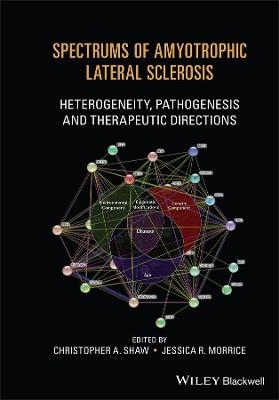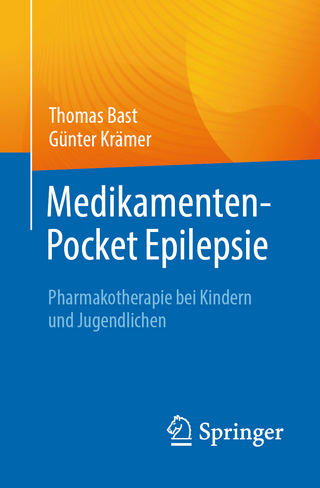
Spectrums of Amyotrophic Lateral Sclerosis
Wiley-Blackwell (Verlag)
978-1-119-74549-5 (ISBN)
In Spectrums of Amyotrophic Lateral Sclerosis: Heterogeneity, Pathogenesis & Therapeutic Directions, distinguished researchers and editors Dr. Christopher A. Shaw and Jessica R. Morrice deliver a practical and powerful perspective on Amyotrophic Lateral Sclerosis (ALS) as a heterogeneous spectrum of disorders. This increasingly accepted point-of-view allows researchers and medical professionals to develop better targeted interventions and more precise therapies.
In the book, readers will find chapters on a wide variety of critical issues facing ALS researchers and healthcare practitioners treating ALS sufferers, including animal models of ALS, neuronal support cells known to have a pivotal role in ALS, and current challenges in ALS clinical trials, among others. The authors describe pathologic features common to all cases of ALS and why animal models, though crucial, should be interpreted with caution. Finally, multiple genetic and environmental etiologies of the disease are discussed.
Readers will also benefit from the inclusion of:
A thorough introduction to ALS as a spectrum disease and the implications for models, therapeutic development and clinical trial design
Explorations of the genetic basis of ALS, prospective sALS etiologies, and the involvement of microbiome in ALS
Discussions of ALS-PDC and environmental risk factors, protein aggregation in ALS, defects in RNA metabolism in ALS, and the non-cell autonomous nature of ALS and the involvement of glial cells
Examinations of animal models of ALS and perspectives on previously failed ALS therapeutics and current therapeutic strategies
Perfect for clinical neurologists, healthcare providers and caretakers, clinicians, and researchers studying motor neuron disease, Spectrums of Amyotrophic Lateral Sclerosis: Heterogeneity, Pathogenesis & Therapeutic Directions is also an indispensable resource for the neurodegenerative research community, neurology residents, and graduate-level neuroscience students.
Contributors xiii
Preface xvii
Acknowledgments xix
Foreword xxi
CHAPTER 1 Clinical Heterogeneity of ALS – Implications for Models and Therapeutic Development 1
Serena Lattante and Mario Sabatelli
Introduction 1
Clinical Heterogeneity of ALS 2
Familial and Sporadic ALS 2
Age of Onset 3
Survival 3
Classic ALS, LMN Form, and UMN Form 4
Site of Onset 4
Diagnosis of ALS 5
ALS and Its Relationship with Frontotemporal
Dementia and Myopathies 5
Pleiotropy of ALS Genes 6
Genetic Models to Study ALS 8
In Vivo Models 8
In Vitro Models 9
Conclusion 10
Conflict of Interest 11
Copyright and Permission Statement 11
References 11
CHAPTER 2 Genetic Basis of ALS 17
Jay P. Ross, Patrick A. Dion, and Guy A. Rouleau
Introduction 17
Genes Causing ALS 18
Superoxide Dismutase 1 (SOD1) 18
TAR DNA‐Binding Protein 43 (TDP‐43) 19
Fused in Sarcoma (FUS) 19
Chromosome 9 Open Reading Frame 72 (C9orf72) 20
Recently Discovered Genes 21
Annexin A11 (ANXA11) 21
Glycosyltransferase 8 Domain Containing 1 (GLT8D1) 23
Stathmin‐2 (STMN2) 23
Aspects of ALS Heritability 24
Sporadic vs. Familial 24
Penetrance and the Oligogenic Hypothesis 24
Multistep Model 25
Noncoding Variation 25
Regulatory and Intronic Variants 25
Epigenetics 26
Conclusions 27
Acknowledgments 27
Conflict of Interest 27
Copyright and Permission Statement 28
References 28
CHAPTER 3 Susceptibility Genes and Epigenetics in Sporadic ALS 35
Jessica R. Morrice, Christopher A. Shaw,
and Cheryl Y. Gregory‐Evans
Introduction 35
Environmental Associations in sALS 36
Genetic Basis of sALS 38
Identification of sALS Susceptibility Genes 39
Candidate sALS Susceptibility Genes 40
Unc13a 40
Dpp6 40
C21orf2 41
Epigenetic Mechanisms in sALS 41
Methylation in sALS 41
miRNAs in sALS 42
Post‐Translational Histone Modification in sALS 43
Epigenetic Analysis in Monozygotic sALS Twins 44
Modifications to the Epigenome by Environmental Factors 44
In Utero Environmental Exposures 45
Environmental in Utero Epigenomic Alterations 45
Post Utero Exposures 45
Conclusion 46
Conflict of Interest 46
Copyright and Permission Statement 47
References 47
CHAPTER 4 The Lessons of ALS‐PDC – Environmental Factors
in ALS Etiology 57
Christopher A. Shaw and Thomas E. Marler
Introduction 57
Koch’s Postulates in the Search of Etiological ALS Factors 58
Neurological Disease Clusters 59
The Natural History of ALS‐PDC 60
Investigating Etiological Factors 62
Identified Cycad Toxicants 67
Aluminum and Ionic Etiologies for ALS‐PDC 69
Other Molecules That Might Have Been Involved in ALS‐PDC 70
A Putative Viral Etiology for ALS‐PDC on Guam
and ALS in General 70
The Continuing Importance of ALS‐PDC 71
Summary and Conclusions 73
Acknowledgments 74
Conflict of Interest 74
Copyright and Permission Statement 74
References 75
CHAPTER 5 The Microbiome of ALS – Does It Start from the Gut? 81
Audrey Labarre and Alex Parker
Introduction 81
Recent Studies 82
Animal and in vitro Studies 82
Clinical Studies 91
How Could the Microbiome Contribute to ALS? 92
Gut Barrier and Membrane Permeability 93
Inflammation and Immune Response 94
Neurotoxins 95
Energy Metabolism 96
Microbiome Modulation as a Potential Therapeutic Avenue 96
Conclusion 97
Conflict of Interest 97
Copyright and Permission Statement 97
References 98
Chapter 6 Protein Aggregation in Amyotrophic Lateral Sclerosis 105
Christen G. Chisholm, Justin J. Yerbury,
and Luke McAlary
Introduction 105
Pathological Protein Inclusions Associated with ALS 106
Protein Homeostasis and Misfolded Protein
Partitioning in ALS 107
Consequences of Protein Aggregation in ALS 108
The Primary Aggregating Proteins in ALS 110
Superoxide Dismutase‐1 (SOD1) 110
Transactivated Response DNA Binding
Protein 43 (TDP‐43) 111
Fused in Sarcoma (FUS) 111
Prion‐like Propagation of Protein Aggregation in ALS 112
Conclusion 113
Acknowledgments 114
Conflict of Interest 114
Copyright and Permission Statement 114
References 114
CHAPTER 7 Evidence for a Growing Involvement of Glia
in Amyotrophic Lateral Sclerosis 123
Rowan A. W. Radford, Andres Vidal‐Itriago,
Natalie M. Scherer, Albert Lee, Manuel Graeber,
Roger S. Chung, and Marco Morsch
Introduction 123
Non‐neuronal Cells Play Important Roles
in Neurodegeneration Including in ALS 123
Glial Cells and Their Established Functions 123
Neurodegeneration and the Role of Glial Cells 124
Glia in ALS 124
Glial Dysfunction Is a Common Hallmark
of ALS Patients 125
Glial Activation in ALS Models 126
Major Pathological Forms of ALS 126
Microglia‐Related ALS Pathology 126
Microglia in SOD1‐ALS Pathology 126
Microglia in TDP‐43‐ALS Pathology 127
Microglia in FUS‐ALS Pathology 128
Astrocyte‐Related ALS Pathology 128
Oligodendrocyte‐Related ALS Pathology
and Glial Inclusion Formation 129
Glial Inclusion Formation in ALS 130
Oligodendrocytes 130
Astrocytes 131
The Role of Glial Cells in SOD1 Pathology Might Be
Different from Other Forms of ALS 131
Conclusion 132
Acknowledgments 134
Conflict of Interest 134
Copyright and Permission Statement 134
References 134
CHAPTER 8 Animal Models of ALS – Current and Future
Perspectives 143
Robert A. Déziel, Amber L. Marriott, Denis G. Kay,
and Daphne A. Gill
Introduction 143
The Clinical Manifestations of ALS 143
Limb Onset 144
Bulbar Onset 144
Respiratory Onset 144
Current and Experimental Pharmacological Interventions 145
Riluzole 145
Edaravone 146
Future Directions for Pharmacological Interventions 146
Causative Factors in the Development of ALS 146
Genetic Factors 146
Environmental and Epigenetic Factors 148
Gut and Microbial Factors 148
Animal Models of ALS 150
One‐hit Models of ALS 150
Multi‐hit Models of ALS 151
Future Model Development 153
Acknowledgments 153
Conflict of Interest 154
Copyright and Permission Statement 154
References 154
CHAPTER 9 Clinical Trials in ALS – Current Challenges
and Strategies for Future Directions 161
Kristiana Salmon and Angela Genge 161
Introduction 161
Challenges in ALS Clinical Trials 162
Disease Heterogeneity 162
Lack of Established Biomarkers 163
Limitations of Conventional Outcome Measures 163
ALSFRS‐R 163
FVC/SVC 164
HHD 164
Survival vs. Function 164
Phase II Trial “Paradox” 165
Patient Recruitment and Retention 166
Assumptions for Lead‐In Phases 166
Navigating Regulatory Nuances 167
Future Directions 167
Advances in Disease Understanding and Assessment 168
Disease Heterogeneity 168
Emerging Biomarkers 168
Novel Outcome Measures 169
New Approaches to Trial Design 170
Cautious Phase II Design 170
Adaptive Trial Design 171
Platform Trials 172
Bayesian Statistics 172
Education 173
People Make or Break a Trial 173
Conclusion 174
Acknowledgments 175
Conflict of Interest 175
Copyright and Permission Statement 175
References 175
CHAPTER 10 Future Priorities and Directions in ALS Research and Treatment 181
Jessica R. Morrice, Michael Kuo,
and Christopher A. Shaw
Introduction 181
Etiological Heterogeneity of ALS 182
ALS Risk Factors 183
Cellular Dysfunction in ALS 185
ALS as a “Treatable” Disease 186
The Importance of Effective Biomarkers 187
Future Therapeutic Avenues for a Heterogeneous Disease 188
Ongoing Clinical Trials Using CuATSM 188
Conclusions and the Road Forward in ALS Research and Treatment 190
Conflict of Interest 191
Copyright and Permission Statement 191
References 191
Index 000
| Erscheinungsdatum | 12.04.2021 |
|---|---|
| Verlagsort | Hoboken |
| Sprache | englisch |
| Maße | 170 x 244 mm |
| Gewicht | 624 g |
| Themenwelt | Medizin / Pharmazie ► Medizinische Fachgebiete ► Neurologie |
| Naturwissenschaften ► Biologie | |
| Schlagworte | Biowissenschaften • Life Sciences • Medical Science • Medizin • Neurologie • Neurology • Neuroscience • Neurowissenschaften |
| ISBN-10 | 1-119-74549-7 / 1119745497 |
| ISBN-13 | 978-1-119-74549-5 / 9781119745495 |
| Zustand | Neuware |
| Haben Sie eine Frage zum Produkt? |
aus dem Bereich


